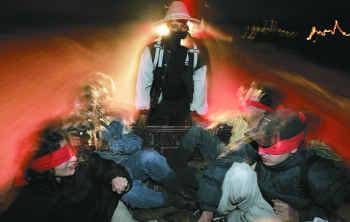 |
 |
 |
 Travel & Outdoors | December 2006 Travel & Outdoors | December 2006  
Illegal Migrant for a Day
 Alfredo Corchado - Dallas Morning News Alfredo Corchado - Dallas Morning News


| | Participants ride blindfolded down a bumpy road with a 'coyote' guide during the nighttime illegal immigrant simulation in Eco Alberto, Mexico. Tourists pay $15 for the opportunity. (Erich Schlegel/DMN) |
Eco Alberto, Mexico – Halfway through the ordeal, my transformation into an illegal immigrant becomes all too real: running through a cornfield at midnight, hiding in a tunnel, sliding down a muddy hill and sloshing through raw sewage.

I tiptoe up a steep ravine and look warily down to a rocky riverbed 20 feet below. With border patrol "agents" hot on my trail, a question forms: When does this game become fun?

This is no ordinary chase, but a mock journey billed as an extreme sport – and one of the most bizarre tourist attractions in Mexico. About a dozen others and I have paid $15 to owners of an ecological park to get a taste of Mexico's timeless tradition: crossing illegally into the U.S.

The real journey is taken annually by tens of thousands of Mexicans – and often turns deadly.

The weekly tourist version takes place at a park in Eco Alberto, 150 miles north of Mexico City in the state of Hidalgo. The park attracts mostly young Mexican professionals.

Fernando López, a 32-year-old engineer from Toluca, is here with his wife, Julia, and 2-year-old daughter, Alison.

"We see a lot of reports on TV about our compatriots dying, so out of respect to them we want to experience it firsthand," Mr. López says.

Adds Julia: "Many of us think the grass is greener on the other side, but that's because we don't know how difficult the journey is. ... So here we are. We want to get a better idea and share it with friends and relatives back home."

The park has multiple purposes, authorities say. First, it creates about 70 jobs in an area where migration to the U.S. – particularly Nevada, Illinois and Texas – is common. Many of the people here belong to the Hnahnu indigenous community, and many migrants come back annually to perform free community service aimed at keeping their culture, language and community thriving.

Second, by teaching Mexicans about the perilous journey, organizers hope to discourage future generations from crossing illegally into the U.S.

Our guide, Luis Santiago Hernández, is a former illegal immigrant who returned to his hometown to do his community service. In his introduction he gives a powerful, nationalistic speech about lives lost along the border, Mexico's potential, and what he calls the exaggerated benefits of living and working in the U.S.

"There's nothing more special and rewarding than waking up in your own home in the morning, in your own land," he told me.

Later, though, Luis admits that once his service ends, he plans to return to Las Vegas.

The would-be immigrants, or tourists, are transported to the banks of a river. Suddenly, border patrol sirens go off, and the cat-and-mouse game is on. We slide down a muddy hill and into knee-deep sewage.

We run past annoyed cows and walk across a narrow ravine. Luis tells me to be careful. One tourist fell recently and broke a rib.

Suddenly, a border patrol "agent" yells, in broken English, "Don't run! The river is deep and dangerous! If you run, we shoot!"

We all crawl inside a tunnel, and no one makes a sound. Sirens and sounds of a motor come close, but then all is quiet again. We quickly leave the tunnel and jump into trucks. We're told to put on blindfolds.

I imagine arriving in a U.S. city with a strip mall. Instead, when the blindfolds come off, we face a mountain illuminated by hundreds of torches, symbolizing migrants who left for the U.S.

Many of the tourists, weary from the two-hour ordeal, look in amazement at the spectacular sight. Luis takes me aside and explains that he dreads his upcoming crossing. This will be his sixth time. I ask whether the crossing will be easier, given that he's the elder tour guide and practices the craft every weekend. Luis smiles.

"This is not even 10 percent of the real thing."

acorchado@dallasnews.com | 
 | |
 |



